[PDF + Audio] Download IELTS Simulation Test miễn phí
IELTS Simulation Test là bộ tài liệu luyện đề được săn đón hàng đầu tại Việt Nam, đặc biệt phù hợp với những bạn đặt mục tiêu Band 5.0 trở lên. Trong bài viết này, TCE sẽ mang đến cho...
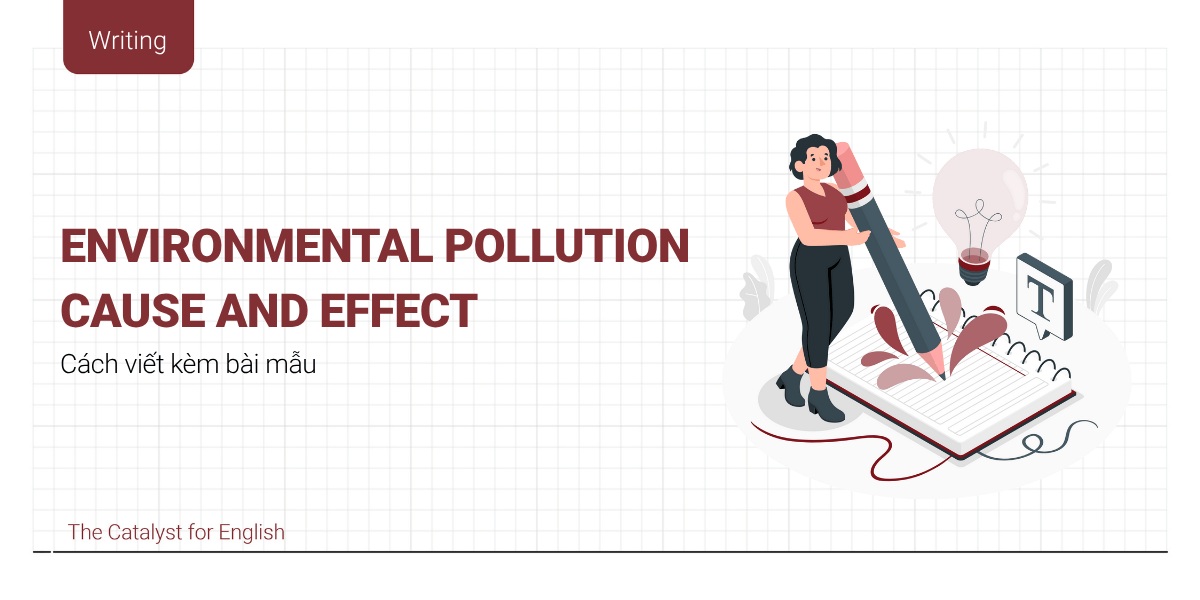
Đề bài Environmental Pollution Cause and Effect là một chủ đề quen thuộc trong IELTS Writing task 2. Chủ đề này yêu cầu thí sinh cần nắm được các kiến thức xã hội về các vấn đề môi trường bên cạnh kiến thức chuyên môn. Do đó, hôm nay The Catalyst for English (TCE) sẽ giúp các thí sinh chinh phục đề bài này nhé!
Đầu tiên. hãy cùng TCE học các từ vựng chủ đề Environmental Pollution nhé!
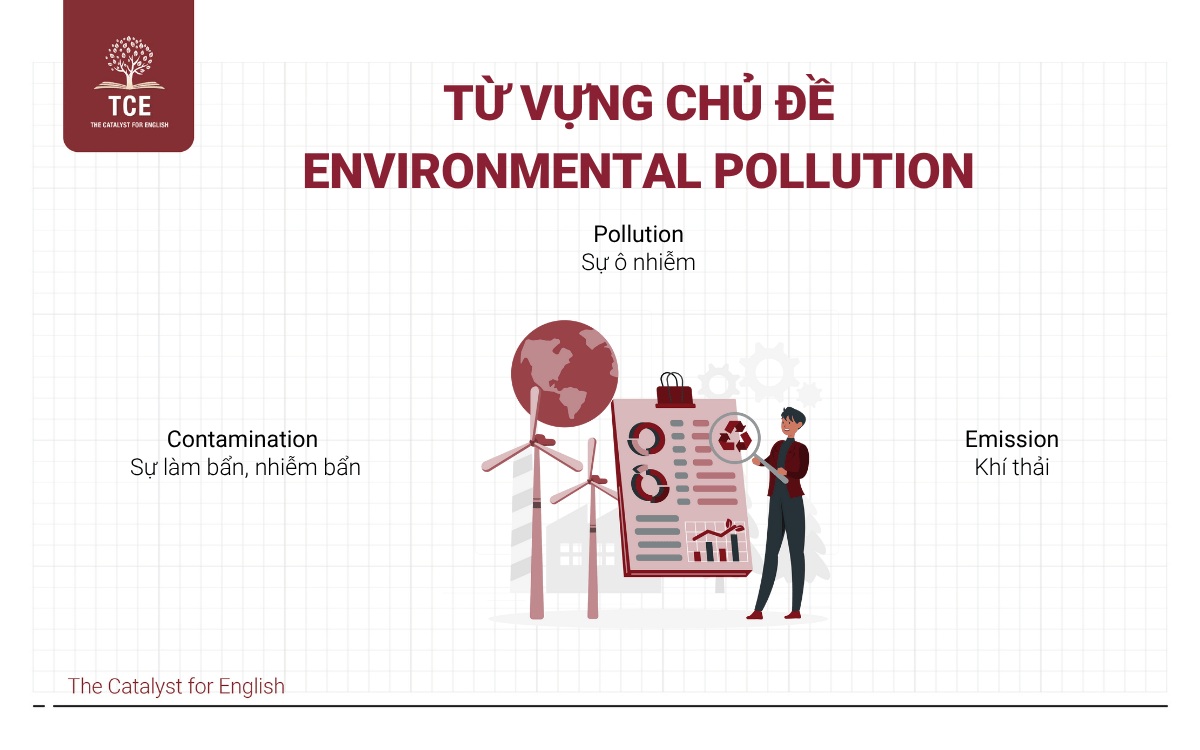
Từ vựng chủ đề Environmental Pollution
| Từ vựng | Phát âm | Ý nghĩa |
| Pollution (n) | /pəˈluːʃn/ | Sự ô nhiễm |
| Contamination (n) | /kənˌtæmɪˈneɪʃn/ | Sự làm bẩn, nhiễm bẩn |
| Emission (n) | /ɪˈmɪʃn/ | Khí thải |
| Toxic waste (n.phr) | /ˈtɒksɪk ˌweɪst/ | Chất thải độc hại |
| Landfill (n) | /ˈlændfɪl/ | Bãi rác |
| Greenhouse gases (n.phr) | /ˈɡriːnhaʊs ˌɡæsɪz/ | Khí nhà kính |
| Acid rain (n.phr) | /ˌæsɪd ˈreɪn/ | Mưa axit |
| Fossil fuels (n.phr) | /ˈfɒsl ˌfjuːəlz/ | Nhiên liệu hóa thạch |
| Renewable energy (n.phr) | /rɪˈnjuːəbl ˈɛnədʒi/ | Năng lượng tái tạo |
| Recycling (n) | /ˌriːˈsaɪklɪŋ/ | Tái chế |
| Waste disposal (n.phr) | /weɪst dɪˈspoʊzəl/ | Xử lý rác thải |
| Carbon footprint (n.phr) | /ˈkɑːbən ˈfʊtprɪnt/ | Dấu chân carbon (lượng CO2 thải ra) |
| Conservation (n) | /ˌkɒnsəˈveɪʃn/ | Sự bảo tồn |
Ngoài việc trang bị vốn từ vựng phù hợp, thí sinh cũng cần chuẩn bị các idea cho chủ đề Environmental Pollution trong IELTS Writing. Bên cạnh đó việc thi thử IELTS 4 kỹ năng là một cách hiệu quả giúp người học kiểm tra năng lực thực tế, rèn phản xạ trong môi trường thi chuẩn và từ đó xác định được chiến lược học tập phù hợp hơn cho từng kỹ năng. Khi đã có sự chuẩn bị đầy đủ, bạn sẽ dễ dàng triển khai các idea cho chủ đề Environmental Pollution trong phòng thi mà không mất quá nhiều thời gian suy nghĩ.
Và để đánh giá chính xác trình độ hiện tại, bạn có thể bắt đầu bằng một buổi thi thử IELTS trên máy tính tại TCE. Đề thi sát thật, mô phỏng chuẩn format thi thật, đi kèm với phần nhận xét chi tiết từ các giảng viên đã đồng hành cùng hàng trăm học viên chinh phục mốc 6.5+. Đây là cơ hội để bạn vừa trải nghiệm không khí thi thật, vừa xác định rõ điểm mạnh – điểm yếu của bản thân.
Đăng ký ngay tại:
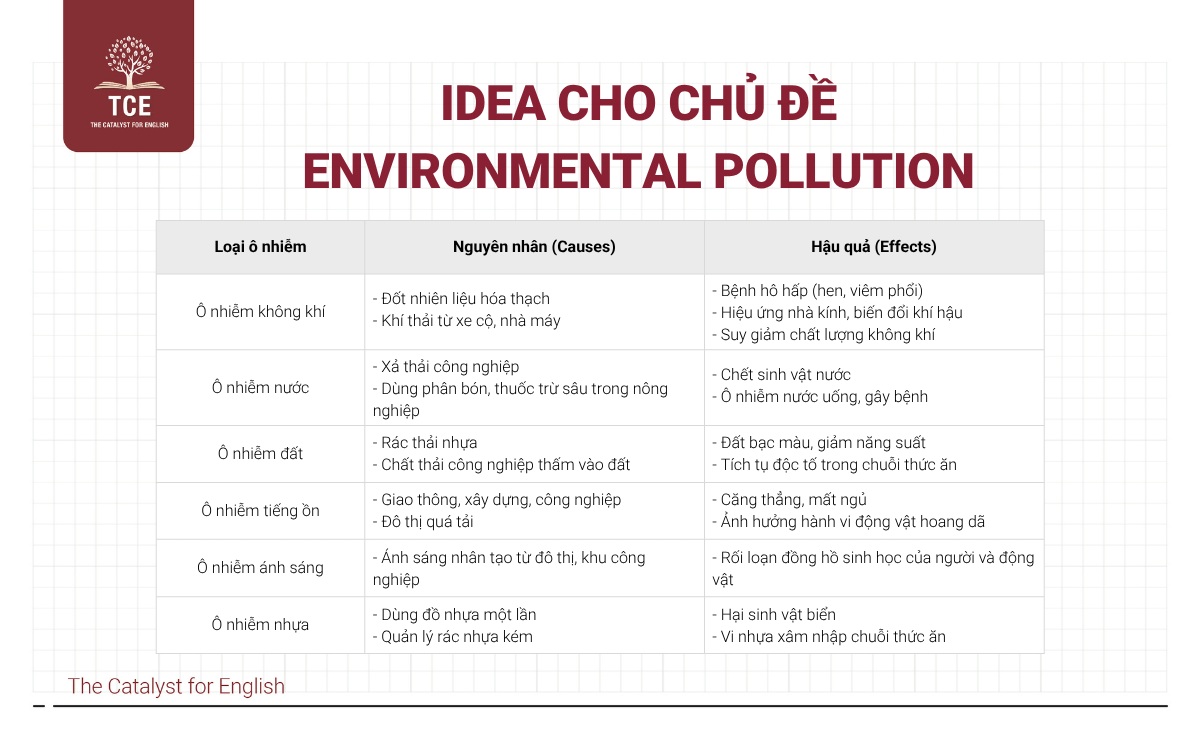
Idea cho chủ đề Environmental Pollution trong IELTS Writing
| Loại ô nhiễm | Nguyên nhân (Causes) | Hậu quả (Effects) |
| Ô nhiễm không khí | – Đốt nhiên liệu hóa thạch trong công nghiệp và giao thông. | – Gây ra các bệnh về hô hấp như hen suyễn và viêm phổi.
– Tăng hiệu ứng nhà kính, gây biến đổi khí hậu. |
| – Khí thải từ xe cộ, nhà máy, và sản xuất năng lượng. | – Suy giảm chất lượng không khí, ảnh hưởng đến sức khỏe con người và động vật. | |
| Ô nhiễm nước | – Xả thải công nghiệp chưa qua xử lý ra sông ngòi, đại dương. | – Giết chết sinh vật dưới nước, làm mất cân bằng hệ sinh thái. |
| – Sử dụng phân bón hóa học và thuốc trừ sâu trong nông nghiệp. | – Ô nhiễm nguồn nước uống, gây bệnh cho con người (như tiêu chảy, nhiễm độc). | |
| Ô nhiễm đất | – Rác thải nhựa không được xử lý đúng cách. | – Đất mất khả năng trồng trọt, làm suy giảm sản lượng nông nghiệp. |
| – Chất thải độc hại từ công nghiệp thấm vào đất. | – Tích tụ chất độc trong chuỗi thức ăn, gây hại cho sức khỏe con người và động vật. | |
| Ô nhiễm tiếng ồn | – Phương tiện giao thông, công trường xây dựng, và hoạt động công nghiệp. | – Gây căng thẳng, mất ngủ, và các vấn đề về sức khỏe tâm lý. |
| – Quá tải dân cư trong đô thị. | – Ảnh hưởng đến động vật hoang dã, làm thay đổi hành vi và môi trường sống của chúng. | |
| Ô nhiễm ánh sáng | – Ánh sáng nhân tạo từ các thành phố và khu công nghiệp. | – Làm rối loạn đồng hồ sinh học của con người và động vật. |
| Ô nhiễm nhựa | – Thói quen sử dụng sản phẩm nhựa dùng một lần (chai nhựa, túi nilon). | – Gây hại cho sinh vật biển do ăn phải nhựa hoặc bị mắc kẹt. |
| – Thiếu các chính sách quản lý rác thải nhựa. | – Nhựa phân hủy tạo ra các vi hạt nhựa, xâm nhập vào chuỗi thức ăn của con người. |
Tiếp theo, TCE sẽ hướng dẫn các thí sinh cách viết bài Environmental Pollution IELTS Writing Task 2 nhé!
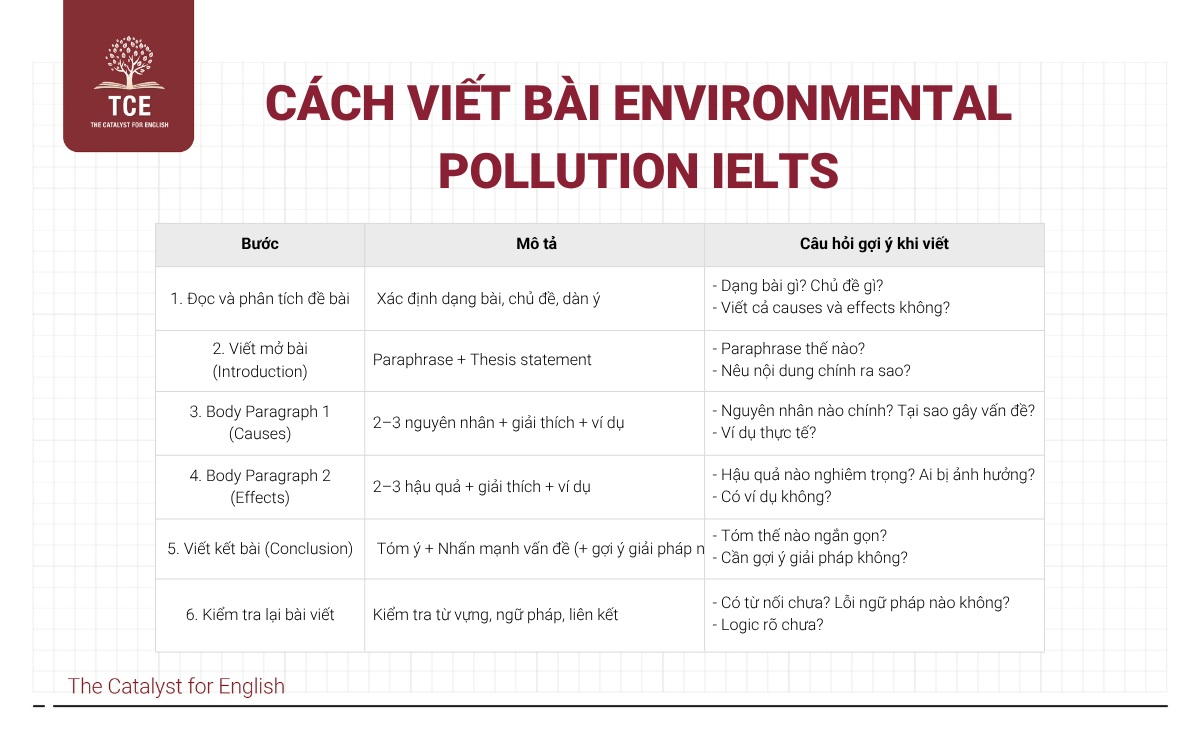
Cách viết bài Environmental Pollution IELTS Writing Task 2
| Bước | Mô tả | Câu hỏi gợi ý khi viết |
| 1. Đọc và phân tích đề bài | – Xác định dạng bài: Cause-Effects.
– Xác định chủ đề: Environmental Pollution. – Lập dàn ý. |
– Đây là dạng bài gì?
– Chủ đề chính là gì? – Có cần viết cả causes và effects không? |
| 2. Viết mở bài (Introduction) | – Paraphrase đề bài (viết lại câu hỏi với từ khác).
– Thêm thesis statement để nêu nội dung chính: “This essay will discuss…” |
– Làm thế nào để paraphrase đề bài?
– Thesis statement nên viết như thế nào? |
| 3. Body Paragraph 1 (Causes) | – Chọn 2-3 nguyên nhân chính.
– Phát triển từng ý: + Giải thích tại sao đây là nguyên nhân. + Đưa ví dụ minh họa thực tế. |
– Nguyên nhân nào quan trọng nhất?
– Tại sao nó gây ra vấn đề? – Có ví dụ thực tế không? |
| 4. Body Paragraph 2 (Effects) | – Chọn 2-3 hậu quả chính.
– Phát triển từng ý: + Giải thích hậu quả xảy ra như thế nào. + Đưa ví dụ minh họa thực tế. |
– Hậu quả chính là gì?
– Ai bị ảnh hưởng? – Ví dụ nào phù hợp? |
| 5. Viết kết bài (Conclusion) | – Tóm tắt ý chính (ngắn gọn).
– Nhấn mạnh mức độ nghiêm trọng của vấn đề. – Có thể thêm gợi ý giải pháp nếu phù hợp. |
– Làm thế nào để tóm tắt gọn nhưng đủ ý?
– Có cần đưa giải pháp không? |
| 6. Kiểm tra lại bài viết | – Đảm bảo từ vựng học thuật (lexical resources).
– Kiểm tra ngữ pháp (grammatical range and accuracy). – Sửa lỗi sai nếu có. |
Sử dụng checklist các yếu tố cần có.
– Có từ nối chưa? – Có lỗi ngữ pháp nào không? – Ý đã logic chưa? |
Còn chần chờ gì nữa mà không khám phá 03 bài mẫu IELTS Writing Task 2 topic Environmental Pollution mà TCE gợi ý cho bạn ngay sau đây:
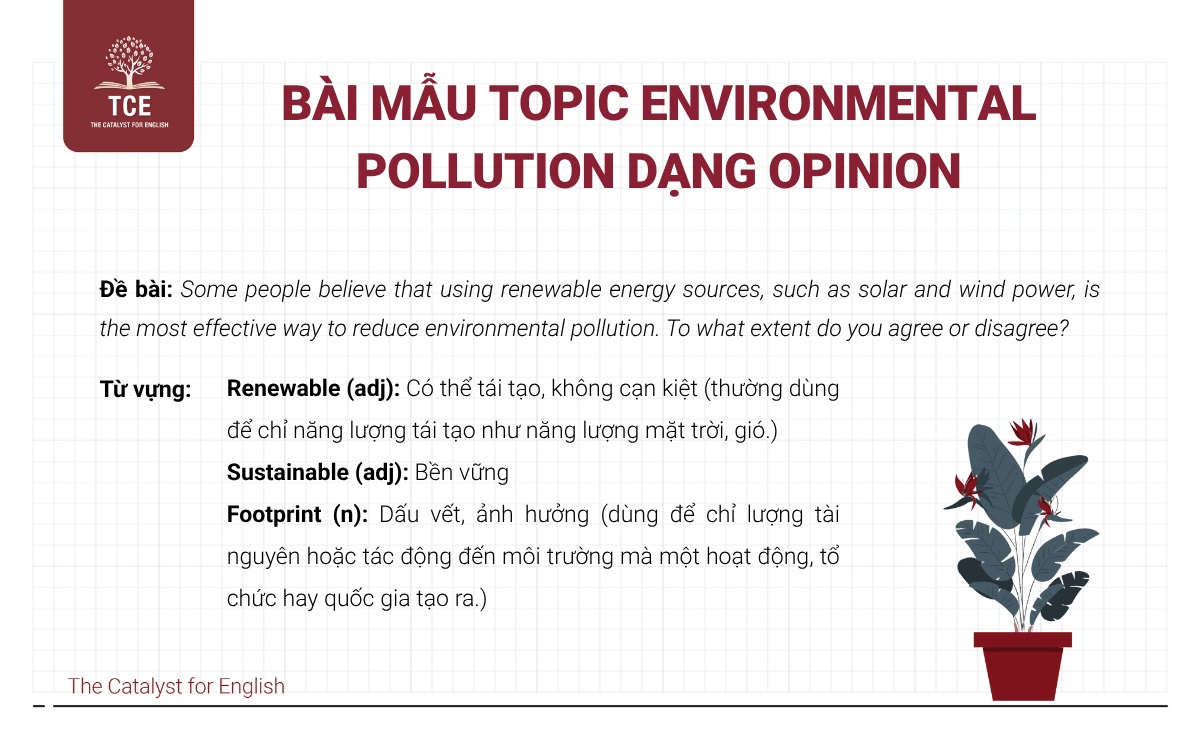
Bài mẫu IELTS Writing Task 2 topic Environmental Pollution dạng Opinion
1. Đề bài 1 (Dạng Opinion): Some people believe that using renewable energy sources, such as solar and wind power, is the most effective way to reduce environmental pollution. To what extent do you agree or disagree?
Bài mẫu:
Environmental pollution is becoming an increasingly global concern, and the search for effective solutions has led many to advocate for the use of renewable energy sources, such as solar and wind power. While I agree that renewable energy plays a vital role in reducing environmental pollution, I believe it is not the sole solution and must be complemented by other measures to achieve maximum impact.
Renewable energy sources are undoubtedly one of the most effective ways to reduce pollution. Unlike fossil fuels, which release large amounts of carbon dioxide and other harmful emissions, solar and wind energy generate clean power with minimal environmental impact. For example, countries like Denmark and Germany have significantly reduced their carbon footprints by transitioning to renewable energy. Furthermore, renewable energy is sustainable and virtually inexhaustible, making it an essential tool for combating long-term environmental degradation. As technological advancements continue to improve the efficiency and affordability of renewables, their adoption will likely accelerate, further reducing pollution levels.
However, relying solely on renewable energy is not sufficient to address all forms of environmental pollution. For instance, solar panel production and wind turbine manufacturing generate waste and consume resources, contributing to pollution during their lifecycle. Moreover, renewable energy is not yet universally accessible or reliable. In developing nations, the high initial costs of installation and the lack of supportive infrastructure hinder widespread adoption. Additionally, intermittent energy production from solar and wind sources, due to weather dependence, necessitates backup systems that may still rely on fossil fuels.
To effectively combat pollution, renewable energy must be combined with other strategies. For example, promoting energy efficiency in industries, homes, and transportation can significantly reduce overall energy consumption and associated emissions. Governments should also enforce stricter regulations on industrial waste management and invest in technologies to reduce water and soil contamination. Public awareness campaigns and educational programs can encourage individuals to adopt eco-friendly practices, such as recycling and reducing single-use plastics. Together, these efforts can address the multifaceted nature of environmental pollution.
In conclusion, while renewable energy sources like solar and wind power are indispensable in reducing environmental pollution, they are not a standalone solution. A comprehensive approach that includes technological innovation, government policies, and individual actions is essential to effectively combat pollution and protect the planet for future generations.
(377 words)
Từ vựng:
| Từ vựng | Phát âm | Ý nghĩa |
| Renewable (adj) | /rɪˈnuːəbl/ | Có thể tái tạo, không cạn kiệt (thường dùng để chỉ năng lượng tái tạo như năng lượng mặt trời, gió.) |
| Sustainable (adj) | /səˈsteɪnəbl/ | Bền vững |
| Footprint (n) | /ˈfʊtprɪnt/ | Dấu vết, ảnh hưởng (dùng để chỉ lượng tài nguyên hoặc tác động đến môi trường mà một hoạt động, tổ chức hay quốc gia tạo ra.) |
| Infrastructure (n) | /ˈɪnfrəˌstrʌktʃər/ | Cơ sở hạ tầng; hệ thống các cấu trúc, phương tiện, và dịch vụ cần thiết cho sự phát triển và hoạt động của xã hội hoặc nền kinh tế. |
| Degradation (n) | /ˌdɛɡrəˈdeɪʃən/ | Sự suy thoái, hư hỏng (thường dùng để chỉ sự giảm sút chất lượng môi trường hoặc tài nguyên thiên nhiên.) |
| Multifaceted (adj) | /ˌmʌltɪˈfæsɪtɪd/ | Đa dạng, nhiều mặt; dùng để chỉ những vấn đề hoặc tình huống có nhiều yếu tố phức tạp cần giải quyết đồng thời. |
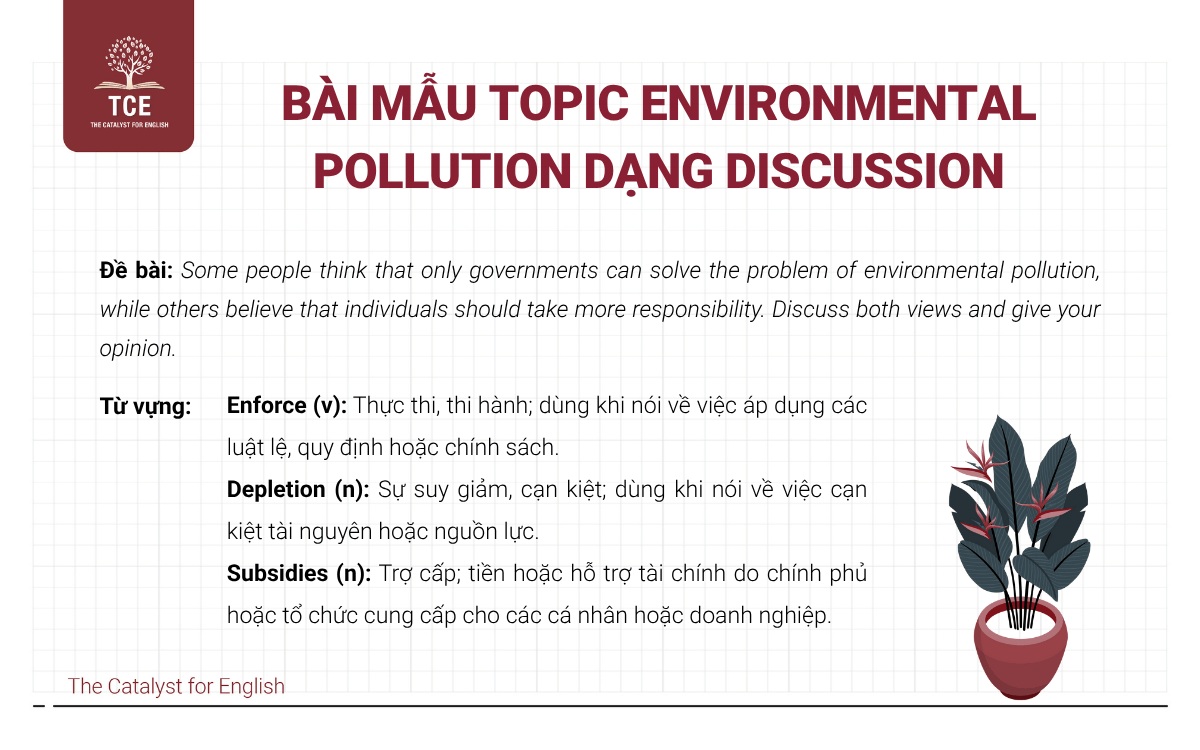
Bài mẫu IELTS Writing Task 2 topic Environmental Pollution Dạng Discussion
2. Đề bài 2 (Dạng Discussion): Some people think that only governments can solve the problem of environmental pollution, while others believe that individuals should take more responsibility. Discuss both views and give your opinion.
Bài mẫu:
Environmental pollution is a major concern worldwide, and finding effective solutions is essential to ensure a sustainable future. While some believe that governments hold the primary responsibility for solving this issue, others argue that individuals should play a bigger role. This essay will discuss both views and present the opinion that both parties must work together to address environmental pollution effectively.
Governments have a significant role in combating environmental pollution because they possess the resources and authority to implement large-scale changes. For instance, they can introduce and enforce laws to limit industrial emissions, regulate waste disposal, and encourage the use of renewable energy. Policies such as banning single-use plastics or providing subsidies for electric vehicles have proven effective in several countries. Furthermore, governments can invest in public infrastructure, such as clean energy plants and efficient public transportation systems, which are essential for long-term environmental sustainability. However, government policies alone cannot succeed without public compliance. Even the most comprehensive regulations, such as recycling programs, require the active participation of individuals to be truly effective.
On the other hand, individuals also play a critical role in addressing pollution by adopting environmentally friendly habits. Actions such as reducing energy consumption, avoiding plastic waste, and using public transportation instead of personal vehicles can collectively make a significant difference. For example, if more people choose to recycle or limit their water usage, it would lead to a substantial reduction in household waste and resource depletion. Moreover, individuals can raise awareness about environmental issues and advocate for policy changes, amplifying the pressure on governments to act. That said, individual efforts alone are limited without systemic changes driven by governments. For instance, people who want to shift to renewable energy may find it unaffordable or inaccessible without government support.
A successful solution to environmental pollution requires collaboration between governments and individuals. Governments need to provide a supportive framework, such as funding green projects and enforcing regulations, while individuals must adopt eco-friendly behaviors and support these initiatives. For example, countries like Japan have achieved remarkable progress in waste management due to strong government policies combined with widespread public cooperation.
In conclusion, both governments and individuals have indispensable roles in addressing environmental pollution. While governments can implement large-scale policies and provide the necessary infrastructure, individuals must take responsibility for their actions and actively support these efforts. Only through a combined approach can we effectively tackle the pressing issue of environmental pollution and ensure a sustainable future.
(407 words)
Từ vựng:
| Từ vựng | Phát âm | Ý nghĩa |
| Enforce (v) | /ɪnˈfɔːrs/ | Thực thi, thi hành; dùng khi nói về việc áp dụng các luật lệ, quy định hoặc chính sách. |
| Depletion (n) | /dɪˈpliːʃən/ | Sự suy giảm, cạn kiệt; dùng khi nói về việc cạn kiệt tài nguyên hoặc nguồn lực. |
| Subsidies (n) | /ˈsʌbsɪdiːz/ | Trợ cấp; tiền hoặc hỗ trợ tài chính do chính phủ hoặc tổ chức cung cấp cho các cá nhân hoặc doanh nghiệp. |
| Amplify (v) | /ˈæmplɪfaɪ/ | Khuếch đại, làm tăng thêm; dùng khi nói về việc gia tăng tác động hoặc ảnh hưởng của một vấn đề, như việc nâng cao nhận thức. |
| Combat (v) | /ˈkəmˌbæt/ | Đấu tranh, chiến đấu; thường dùng trong ngữ cảnh chống lại các vấn đề như ô nhiễm. |
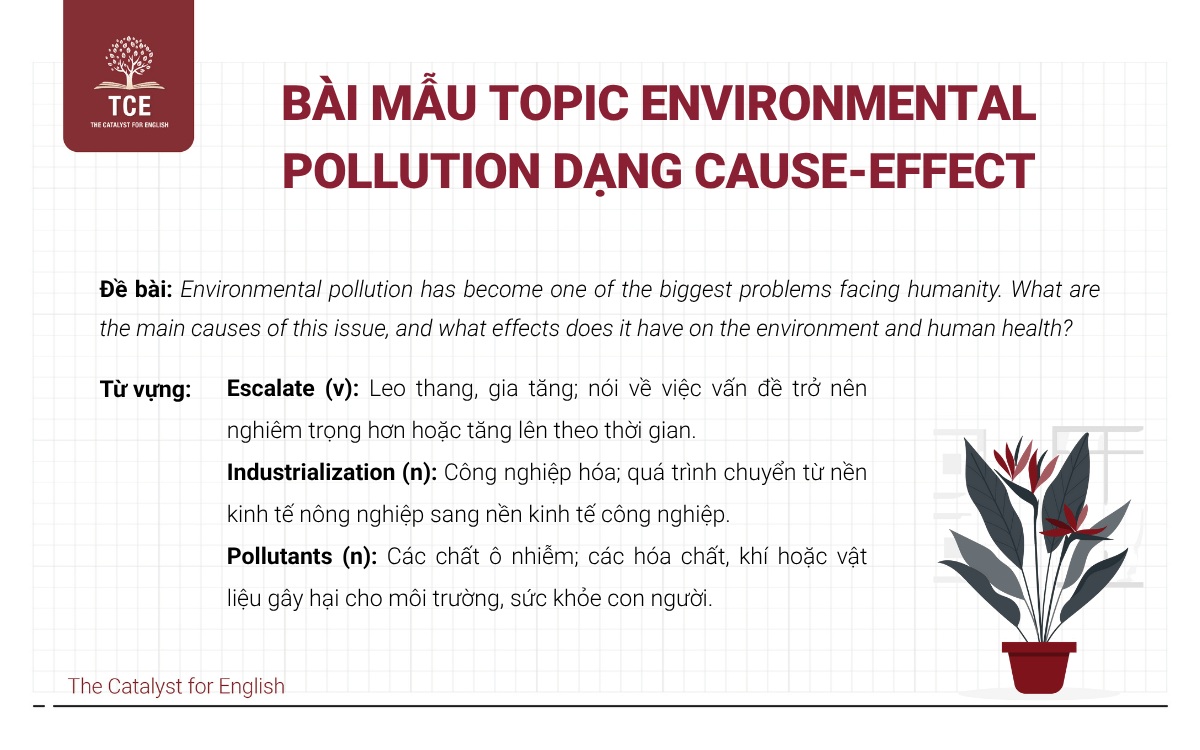
Bài mẫu IELTS Writing Task 2 topic Environmental Pollution Dạng Cause-Effect
3. Đề bài 3 (Dạng Cause-Effect): Environmental pollution has become one of the biggest problems facing humanity. What are the main causes of this issue, and what effects does it have on the environment and human health?
Bài mẫu:
Environmental pollution has escalated into one of the most pressing global issues today. According to environmental science and pollution research, the causes of this problem are numerous, but human activities, particularly industrialization and urbanization, are the primary contributors. This essay will explore the main causes of environmental pollution and discuss its adverse effects on both the environment and human health.
The primary cause of environmental pollution is the rapid industrialization and urbanization that has taken place over the last century. Industrial activities, such as manufacturing, mining, and transportation, release large amounts of harmful pollutants into the air, water, and soil. For example, factories emit carbon dioxide, sulfur dioxide, and other gases that contribute to air pollution and climate change. Similarly, the burning of fossil fuels for energy production significantly worsens air quality and increases global warming.
Another significant contributor is deforestation. As forests are cleared for agriculture and urban development, not only is biodiversity lost, but the ability of ecosystems to absorb carbon dioxide is also reduced. Additionally, the extensive use of plastic in daily life, which does not decompose easily, leads to widespread pollution of oceans and landfills.
The effects of environmental pollution are severe, both on ecosystems and biodiversity. Air pollution, for instance, harms plant and animal life by disrupting their natural habitats and altering climate patterns. Acid rain, caused by pollutants such as sulfur dioxide and nitrogen oxides, damages forests, rivers, and buildings. Water pollution, primarily from industrial waste and agricultural runoff, contaminates water sources, endangering aquatic life and disrupting food chains. Moreover, plastic pollution in oceans poses a direct threat to marine life, as many animals mistake plastic for food, which can lead to death or injury.
The impact of pollution on human health is equally alarming. Air pollution is linked to respiratory diseases such as asthma, bronchitis, and lung cancer. Studies have shown that individuals living in highly polluted areas are at a greater risk of developing these conditions. Water contamination, due to chemicals and toxins, can lead to waterborne diseases like cholera, dysentery, and typhoid fever. Moreover, soil pollution affects agriculture, as contaminated soil can produce unhealthy crops, leading to foodborne illnesses. Prolonged exposure to hazardous substances in polluted environments can also cause long-term health problems, such as cancer and neurological disorders.
In conclusion, environmental pollution is caused by various human activities, with industrialization, deforestation, and plastic use being the leading contributors. The consequences of environmental pollution are widespread, impacting ecosystems, wildlife, and human health. Addressing this issue requires global cooperation, stricter environmental regulations, and individual responsibility to reduce emissions, conserve resources, and adopt sustainable practices. Only through these collective efforts can we mitigate the harmful impacts of pollution and ensure a healthier planet for future generations.
(442 words)
Từ vựng:
| Từ vựng | Phát âm | Ý nghĩa |
| Escalate (v) | /ˈɛskəˌleɪt/ | Leo thang, gia tăng; nói về việc vấn đề trở nên nghiêm trọng hơn hoặc tăng lên theo thời gian. |
| Industrialization (n) | /ɪnˌdʌstriəlaɪˈzeɪʃən/ | Công nghiệp hóa; quá trình chuyển từ nền kinh tế nông nghiệp sang nền kinh tế công nghiệp. |
| Pollutants (n) | /pəˈluːtənts/ | Các chất ô nhiễm; các hóa chất, khí hoặc vật liệu gây hại cho môi trường, sức khỏe con người. |
| Ecosystems (n) | /ˈiːkəʊsɪstəmz/ | Hệ sinh thái; cộng đồng sinh vật và môi trường sống của chúng, cùng với các yếu tố tương tác trong tự nhiên. |
| Contaminate (v) | /kənˈtæmɪneɪt/ | Làm ô nhiễm, làm hư hỏng; sự pha trộn của các chất độc hại vào môi trường, gây hại cho sức khỏe và hệ sinh thái. |
| Waterborne (adj) | /ˈwɔːtəbɔːrn/ | Lây qua nước; mô tả các bệnh hoặc vi khuẩn có thể truyền qua nguồn nước bị ô nhiễm. |
| Neurological (adj) | /ˌnjʊərəˈlɒdʒɪkəl/ | Thuộc thần kinh học; liên quan đến hệ thần kinh hoặc các bệnh về hệ thần kinh, như rối loạn thần kinh. |
Vậy là chúng ta đã cùng nhau khám phá cách làm bài và tham khảo bài mẫu cho dạng Environmental Pollution Cause and Effect. Nếu bạn muốn luyện tập thêm nhiều dạng bài khác thuộc kỹ năng này, đừng quên ghé qua chuyên mục IELTS Writing của TCE – nơi tổng hợp những hướng dẫn chi tiết, dễ hiểu và sát với đề thi thực tế từ đội ngũ chuyên môn nhiều kinh nghiệm.